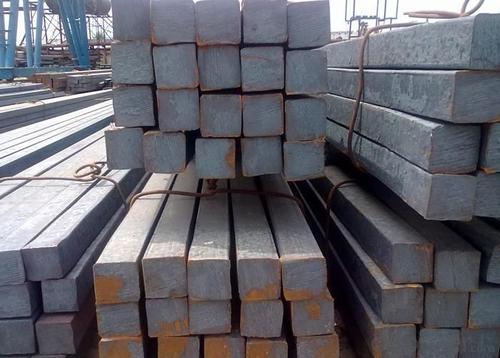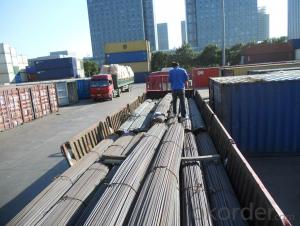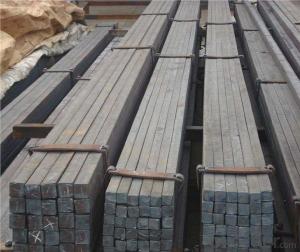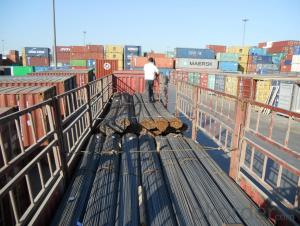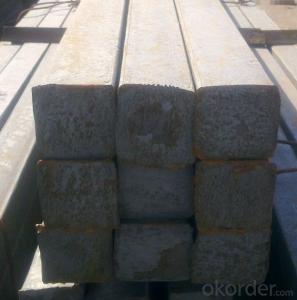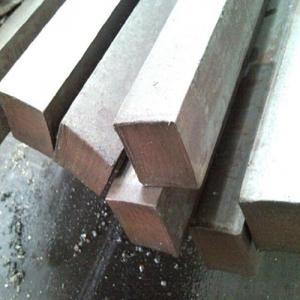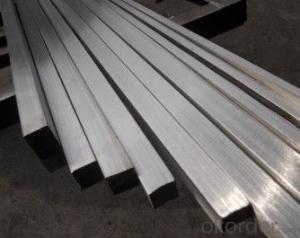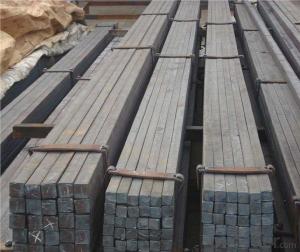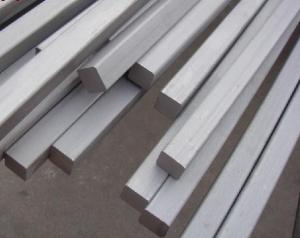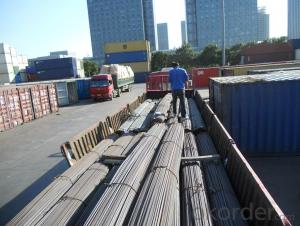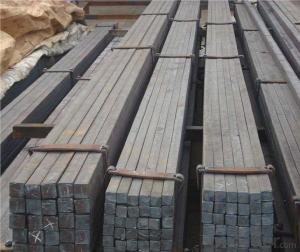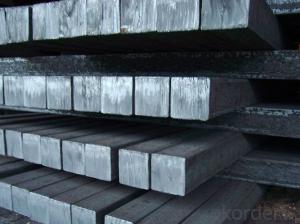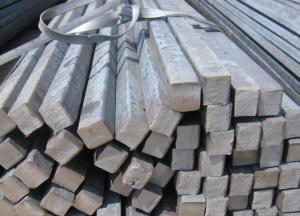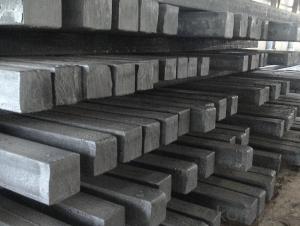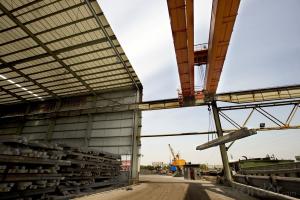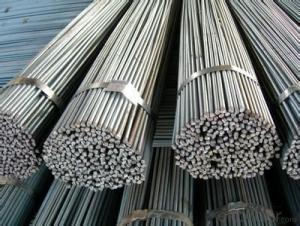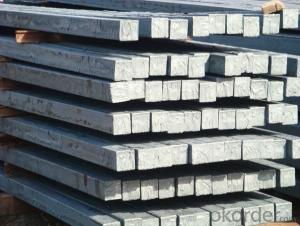Square steel bar
- Loading Port:
- China Main Port
- Payment Terms:
- TT or LC
- Min Order Qty:
- 50Tons m.t.
- Supply Capability:
- 500 tons per month m.t./month
OKorder Service Pledge
OKorder Financial Service
You Might Also Like
We offer Square Steel Bar with grade Q195 / Q235
Specifications of Square Steel Bar:
-Standard: GB,
-Grade: Q195/Q235 or equivalent.
Chemical Composition:
-Chemical Composition. Q195
|
Standard |
Grade |
Element (%) | ||||
|
GB |
Q195 |
C |
Mn |
S |
P |
Si |
|
0.06~0.12 |
0.25~0.50 |
≤0.050 |
≤0.045 |
≤0.30 | ||
-Chemical Composition. Q235
|
Standard |
Grade |
Element (%) | ||||
|
GB |
Q235B |
C |
Mn |
S |
P |
Si |
|
0.12~0.20 |
0.30~0.70 |
≤0.045 |
≤0.045 |
≤0.30 | ||
Measures and Tolerances of Square Steel Bar:
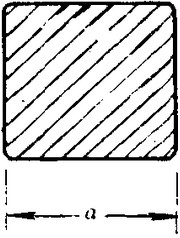
(The section of Square Steel Bar)
-The length of a side and the theoretical weight of Square Steel.
|
Length of a side(a, mm) |
Theoretical weight(kg/m) |
Length of a side(a, mm) |
Theoretical weight(kg/m) |
|
6 |
0.283 |
32 |
8.04 |
|
7 |
0.385 |
*33 |
8.55 |
|
8 |
0.502 |
34 |
9.07 |
|
9 |
0.636 |
*35 |
9.62 |
|
10 |
0.785 |
36 |
10.17 |
|
11 |
0.950 |
38 |
11.24 |
|
12 |
1.13 |
40 |
12.56 |
|
13 |
1.33 |
42 |
13.85 |
|
14 |
1.54 |
45 |
15.90 |
|
15 |
1.77 |
48 |
18.09 |
|
16 |
2.01 |
50 |
19.63 |
|
17 |
2.27 |
53 |
22.05 |
|
18 |
2.54 |
*55 |
23.6 |
|
19 |
2.82 |
56 |
24.61 |
|
20 |
3.14 |
*58 |
26.4 |
|
21 |
3.46 |
60 |
28.26 |
|
22 |
3.80 |
63 |
31.16 |
|
*23 |
4.15 |
*65 |
33.17 |
|
24 |
4.52 |
*68 |
36.3 |
|
25 |
4.91 |
79 |
38.49 |
|
26 |
5.30 |
75 |
44.16 |
|
*27 |
5.72 |
80 |
50.24 |
|
28 |
6.15 |
85 |
56.72 |
|
*29 |
6.60 |
90 |
63.59 |
|
30 |
7.06 |
95 |
70.85 |
|
*31 |
7.54 |
100 |
78.50 |
Notes:
1, The theoretical weights in the list, base on the density of 7.85 g/cm3.
2, The numbers with *mean that they are not regulars or we don’t offer them.
-The allowed tolerance of Square Steel:
|
Length of a side(mm) |
Allowed Tolerance | ||
|
Group1 |
Group2 |
Group3 | |
|
5.5~7 |
±0.20 |
±0.30 |
±0.40 |
|
7~20 |
±0.25 |
±0.35 |
±0.40 |
|
20~30 |
±0.30 |
±0.40 |
±0.50 |
|
30~50 |
±0.40 |
±0.50 |
±0.60 |
|
60~80 |
±0.60 |
±0.70 |
±0.80 |
|
80~110 |
±0.90 |
±1.0 |
±1.1 |
|
110~150 |
±1.2 |
±1.3 |
±1.1 |
|
150~190 |
―― |
―― |
±2.0 |
|
190~250 |
―― |
―― |
±2.5 |
Usage/Applications of Steel Square Bar:
-The Square Steel is normally used as structure steel.
-Row material for other structure steel like steel angles, channels, I-beams, H-beams, etc…
Packaging & Delivery of Steel Square Bar:
-Packing Detail: The products can be packed in bundles by steel wires.
-Marks:
1, Tag marks: the tag marks will be tied up to each bundle of the products. The information is usually including supplier’s logo and name, product name, made in China, products’ specifications, the painted color and other information requested by customers.
2, Color marks: we will paint both ends of the bundles of these products to make sure that they are more evident. It’s will be more convenient for the customers to distinguish them at the destination port.
-Delivery Detail: 30~45 working days after receive buyer’s T.T. or L/C.
Transportation:
-The products can be delivered by bulk vessel or by container. As for container, products with the length of 6m will be loaded in 20’ container, with 9m or 12m, in 40’ container.
-The maximum quantity of loading of container is 25 tons.
-The products usually are transported to the nearest port from the production place.
Payment:
-Invoicing on theoretical weight or actual weight a s customer’s request.
-FOB, CFR or CIF.
-Regular terms of payment:
1, 30% payment in advance, the remaining balance (70% payment) against the copy of B/L.
2, 30% payment in advance, the remaining balance (70% L/C) against the copy of B/L.
3, Negotiable.
Photos of Square Steel Bar:
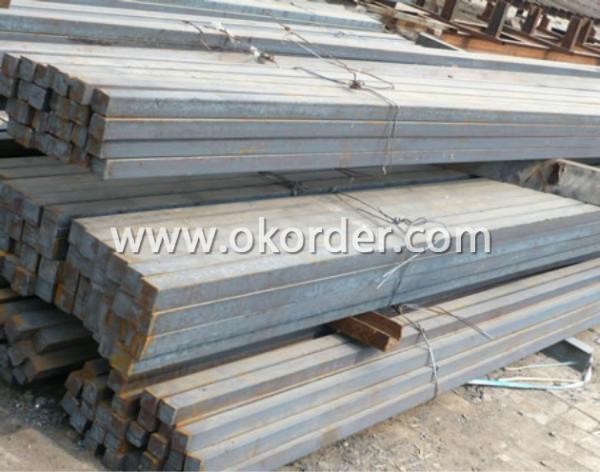
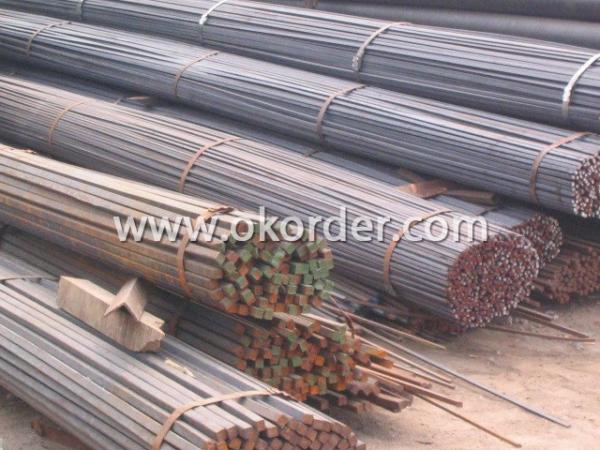
We sincerely welcome partners around the world to establish business cooperation with us on the basis of mutual trust, benefit and development.
- Q: How do you use a steel square for marking stair tread and riser dimensions?
- To use a steel square for marking stair tread and riser dimensions, first, position the square on the edge of the tread or riser. Align one leg of the square with the edge and the other leg perpendicular to it. Then, using a pencil, mark the desired dimensions by tracing along the edge of the square. This ensures accurate and consistent measurements for each step of the staircase.
- Q: How do you use a steel square to determine the height of a step?
- To determine the height of a step using a steel square, you can place one leg of the square on the ground and the other leg against the vertical riser of the step. By aligning the 90-degree angle of the square with the horizontal ground, you can measure the vertical distance from the ground to the top of the step using the markings on the steel square.
- Q: How does a steel square assist in determining the correct angle for a canted cut?
- A steel square assists in determining the correct angle for a canted cut by providing a reliable and precise measurement tool. It allows for accurate marking and alignment of the desired angle, ensuring the cut is made at the correct inclination.
- Q: Can a steel square be used for fence-building projects?
- Yes, a steel square can be used for fence-building projects. A steel square, also known as a framing square or a carpenter's square, is a versatile tool that is commonly used in construction and woodworking projects. It can help ensure accurate and square cuts, angles, and measurements, which are essential for building a sturdy and well-aligned fence. Whether you are constructing a wooden fence or a metal fence, a steel square can be used to lay out the fence posts, mark the angles for cuts, and check for squareness during the installation process. It is a valuable tool for any fence builder and can greatly assist in achieving precise and professional results.
- Q: Are there any limitations to using a steel square?
- Yes, there are some limitations to using a steel square. Firstly, its accuracy may be affected by wear and tear over time, leading to slight deviations in measurements. Additionally, its size may restrict its use in certain situations or for larger projects. Lastly, a steel square may not be suitable for projects that require precise angles or measurements beyond its limited range.
- Q: Can a steel square be used for checking the squareness of a lathe tailstock?
- No, a steel square is not suitable for checking the squareness of a lathe tailstock. A precision square specifically designed for this purpose should be used to ensure accurate measurements and alignment.
- Q: How do you use a steel square to mark out 75-degree angles?
- To use a steel square to mark out 75-degree angles, you would typically align the 45-degree angle of the square with the edge of the material. Then, using a protractor or angle finder, measure 30 degrees from the square's 45-degree angle, which will give you a total of 75 degrees. Finally, draw a line along the edge of the square to mark out the 75-degree angle.
- Q: How do you use a steel square to find the center of an irregular shape?
- To use a steel square to find the center of an irregular shape, you can follow these steps: 1. Place the steel square on a flat surface, ensuring that it is aligned properly. 2. Position the irregular shape within the steel square, making sure that it is fully contained within the square and that its edges are parallel to the sides of the square. 3. Identify the diagonal lines of the steel square by drawing imaginary lines connecting opposite corners of the square. 4. Extend these diagonal lines beyond the edges of the square. 5. Observe where the extended diagonal lines intersect with the irregular shape. 6. Mark the points of intersection on the shape. 7. Draw a straight line connecting the marked points of intersection. 8. Repeat the process by rotating the steel square and aligning it with different edges of the irregular shape. 9. Where the lines from multiple rotations intersect is the approximate center of the irregular shape. It's important to note that using a steel square to find the center of an irregular shape will give you an approximate center, as the method assumes that the shape is symmetrical.
- Q: Can a steel square be used for retaining wall layout and construction?
- Utilizing a steel square, commonly referred to as a framing square, is essential for the layout and construction of a retaining wall. This versatile tool serves various purposes in the field of carpentry and construction. It proves particularly valuable when it comes to measuring and marking right angles, a crucial aspect of accurately setting up a retaining wall. When undertaking the construction of a retaining wall, it becomes imperative to meticulously measure and mark all angles to guarantee the wall's levelness and structural stability. By utilizing a steel square, one can measure and mark right angles, which are indispensable for establishing the foundation and corners of the wall. Consequently, this ensures that the wall is constructed in a straight manner and adheres to the desired layout. Furthermore, the steel square serves as a means to assess the squareness of the wall throughout the construction process. By placing the square against the wall's corners and edges, one can verify their alignment with perfect right angles. Such an approach aids in upholding the integrity and stability of the retaining wall. To summarize, a steel square proves to be an invaluable tool for both layout and construction of a retaining wall. Its ability to facilitate accurate measurement and marking of right angles ensures that the wall is constructed in a straight, level, and structurally sound manner.
- Q: Can a steel square be used for checking the alignment of deck boards?
- Yes, a steel square can be used for checking the alignment of deck boards. A steel square, also known as a framing square or carpenter's square, is a versatile tool commonly used in woodworking and construction. It consists of a long arm and a shorter perpendicular arm, forming an "L" shape. The long arm can be used as a straightedge to ensure the deck boards are aligned properly. To check the alignment of deck boards using a steel square, place the long arm of the square against the edge of one deck board and extend it across the neighboring boards. This will allow you to visually inspect if the boards are parallel and evenly spaced. The shorter arm can also be used to measure the gap between boards to ensure consistent spacing. Furthermore, the square can be used to check the corners and angles of the deck to ensure they are square and properly aligned. This is important for structural stability and aesthetic appeal. However, it is worth mentioning that while a steel square can be a useful tool for checking alignment, it may not be the most precise option. For greater accuracy, specialized tools such as a laser level or string line may be more suitable for checking the alignment of deck boards.
1. Manufacturer Overview
| Location | Renqiu, China |
| Year Established | 1996 |
| Annual Output Value | Above US$ 30 Million |
| Main Markets | Mid East; Southeast Aisa |
| Company Certifications |
2. Manufacturer Certificates
| a) Certification Name | |
| Range | |
| Reference | |
| Validity Period |
3. Manufacturer Capability
| a) Trade Capacity | |
| Nearest Port | Tianjin; |
| Export Percentage | 20% - 30% |
| No.of Employees in Trade Department | 11-20 People |
| Language Spoken: | English; Chinese |
| b) Factory Information | |
| Factory Size: | Above 70,000 square meters |
| No. of Production Lines | 1 |
| Contract Manufacturing | OEM Service Offered |
| Product Price Range | Average |
Send your message to us
Square steel bar
- Loading Port:
- China Main Port
- Payment Terms:
- TT or LC
- Min Order Qty:
- 50Tons m.t.
- Supply Capability:
- 500 tons per month m.t./month
OKorder Service Pledge
OKorder Financial Service
Similar products
Hot products
Hot Searches
Related keywords



